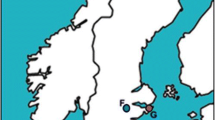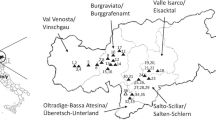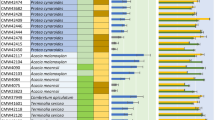Abstract
On the basis of mycelial compatibility, the population structure of Valsa ceratosperma, the causal fungus of Valsa canker on broadleaf trees, was investigated in apple and pear orchards in Japan. Field strains of V. ceratosperma from a single canker on trunks or scaffold limbs belonged to different mycelial compatibility groups. Thus, the population structure of this fungus was complex in most orchards. Because mycelia of strains originating from different conidia from the same pycnidium were compatible, infection by this fungus is thought to be ascospores.
Similar content being viewed by others
Avoid common mistakes on your manuscript.
An ascomycetous phytopathogenic fungus, Valsa ceratosperma (Tode ex Fries) Maire, is parasitic on many kinds of broadleaf trees including fruit trees and causes Valsa canker (Kobayashi 1970). Valsa canker, in Japan, China, and in the Korean peninsula, is characterized by cankers on trunks and scaffold limbs or diebacks of twigs. In Japan, because of repeated, serious outbreaks, V. ceratosperma has caused heavy damage to apple production since its discovery (Sakuma 1990). Valsa ceratosperma also infects pear trees (Saito et al. 1972).
Mycelial incompatibility between different strains of a fungal species has been found in many ascomycetes (Adams et al. 1990; Anagnostakis and Waggoner 1981; Begueret et al. 1994), basidiomycetes (Hansen et al. 1993; Katsumata et al. 1996), and deuteromycetes (Rayner 1976). This phenomenon can be detected on appropriate agar media as a demarcation line or barrage zone that forms when hyphae from two incompatible isolates fuse. In general, because mycelial incompatibility is related to genetic differences among fungal strains (Kohn et al. 1991), knowledge of the population structure of phytopathogenic fungi can provide epidemiologically important information. That is, complexity in population structure develops from the frequent genetic recombination, such as mating, within the fungal population (Adams et al. 1990).
Although Harada (1977) has described a phenomenon that might be related to mycelial incompatibility in V. ceratosperma, little is known regarding the population structure of this fungus in orchards. In the present study, the population structure of V. ceratosperma was studied by looking for mycelial compatibility among strains in apple and pear orchards.
The population structure of V. ceratosperma was investigated in two areas in the apple orchards of the Apple Research Station, National Institute of Fruit Tree Science (NIFTS, Iwate, Japan) and in one apple orchard and two pear orchards in the northern Nagano. Apple and pear orchards in Nagano were used for commercial purposes. All the investigated apple orchards were surrounded by other orchards. The pear orchards were located diagonally opposite and an arterial road runs between the orchards. The pear orchards were also surrounded by rice fields.
All apple or pear trees planted in the investigated orchards were examined for the development of Valsa canker. Diseased tissue was taken from one canker on the trunk or scaffold limb of each infected tree. Tissue from twigs with dieback was not sampled. When the major axis of the canker was less than or equal to 15 cm, diseased tissue was taken from both margins on the major axis of the canker. When the major axis of the canker was longer than 15 cm, five different margins of the canker including both margins on the major axis were sampled. Diseased tissues in a 2-cm square were excised with pruning scissors. The pruning scissors were flame-disinfected after every sampling. Sampled tissues were cut into 5-mm squares in the laboratory, then surface-sterilized with a consecutive treatment of 70% ethanol (1 min) and 0.1% sodium hypochlorite (5 min). Surface-sterilized tissues were then rinsed with sterilized water and placed on potato dextrose agar plates (PDA, Becton Dickinson, NJ, USA). Growing hyphae from the tissues were transferred onto 1.6% water agar plates and cultured for 1 week on an workbench. Two hyphal tips growing on water agar plates were then dissected from each tissue sample using a Nikon SMZ-2T stereomicroscope (Nikon, Kawasaki, Japan) and transferred onto fresh PDA plates.
The isolates collected from the apple or pear orchards were identified as V. ceratosperma by their cultural morphology on PDA medium and an inoculation test on dormant apple twigs. The inoculation test was performed according to the method of Tamura et al. (1973), and all isolates caused cankers on apple twigs. Genomic DNA was extracted from the isolates by the methods described by Bousquet et al. (1990) and Wagner et al. (1987), and the internal transcribed spacer (ITS) regions were amplified by a polymerase chain reaction (PCR) using PCR primers, ITS1 (5′-TCCGTAGGTGAACCTGCGG-3′) and ITS4 (5′-TCCTCCGCTTATTGATATGC-3′) (White et al. 1990). The amplified ITS regions from the V. ceratosperma isolates were then digested with restriction enzymes HaeIII, HinfI, MspI or TthHB8I (Takara Bio, Ohtsu, Japan) and the restriction fragments were separated by 2% agarose gel electrophoresis. Isolate VC88PS (preserved as MAFF645003 in NIAS Genebank, National Institute of Agrobiological Sciences, Tsukuba) was used as a control, and the restriction fragment patterns of all isolates coincided with the pattern of the isolate VC88PS.
Mycelial incompatibility among the isolates of V. ceratosperma was screened in 9-cm diameter Petri dishes with the following media: (1) 1.6% water agar, (2) potato dextrose agar (Becton Dickinson), (3) Czapek agar (Becton Dickinson), (4) cornmeal agar (Becton Dickinson), (5) oatmeal agar (Becton Dickinson), (6) self-made oatmeal agar (75 g of commercial oatmeal was boiled in 1 l of distilled water. Then 16 g of agar was added.), (7) clarified oatmeal agar (COMA, Adams et al. 1990), (8) 1% malt extract agar, (9) 5% malt extract agar, and (10) 10% malt extract agar. Two of our five isolates of V. ceratosperma (PV-17, TM-1, VC88PS, MAFF410498 and MAFF410514) were paired on these media in all possible combinations. Isolate PV-17, isolated from a pear tree in Nagano was a gift of Mr. Yasumitsu Kawai (Nagano Plant Protection Office). Isolate TM-1, isolated from an apple tree in Aomori, Japan, was a gift of Mr. Kinsuke Yukita (Apple Experiment Station, Aomori Prefectural Agriculture and Forestry Research Center). MAFF isolates were obtained from the NIAS Genebank. Paired V. ceratosperma isolates were cultured for 2 weeks at 20°C in the dark, and the cultures with a dark demarcation line between colonies were then marked. A dark demarcation line appeared the most quickly on the Becton Dickinson (BD) oatmeal agar, with a line developing within a week. A dark demarcation line formed with all pairwise combinations of the isolates on BD oatmeal agar. These same isolate pairs, however did not always form a demarcation line on the other culture media. Thus, BD oatmeal agar medium was the most effective for detecting mycelial incompatibility for V. ceratosperma and used for further studies on the population structure in apple or pear orchards.
After, mycelial compatibility among all isolates from each canker was determined on BD oatmeal agar (Fig. 1). The population structure in each orchard was determined based on the mycelial compatibility among isolates collected from the respective cankers. A demarcation line between colonies of isolates that were taken from different cankers in the same orchards emerged within a week, and pycnidia formed along the demarcation line about 1 month from the start of the compatibility test. In apple orchards of the NIFTS, two diseased tissues were sampled from a canker on the affected trees indicated as a filled circle in Figs. 2 and 3, and five diseased tissues were sampled from the trees indicated as circle within open circle in the first and eighth rows in Fig. 2. In most cases, canker was dominated by a single mycelial compatibility group (MCG) in these two orchards. On two trees, however, more than one MCG was found in a canker (indicated as circle within open circle). Specifically, four monomycelial isolates belonged to MCG1, and six monomycelial isolates belonged to MCG2 in a canker on the tree in row 1. Two monomycelial isolates in MCG5 and eight monomycelial isolates in MCG6 were also confirmed in a canker on the tree in row 8. MCGs of V. ceratosperma differed from canker to canker in respective apple orchards (Figs. 2, 3). None of the MCGs were common to both apple orchards of the NIFTS. In an apple orchard in Nagano, two diseased tissues sampled from a canker had MCG1, 3 and 4, and five samples from a canker had MCG2 (Fig. 4). All cankers investigated in this orchard were also dominated by a single MCG, and the MCGs differed from canker to canker, that is, the cankers had no MCG in common (Fig. 4). In pear orchards, two samples were taken from one canker on each tree, and each canker was dominated by a single MCG, with different MCGs differed from canker to canker, that is, the cankers had no MCG in common like the apple orchards (Fig. 5). However, MCG2 was found on separate trees in orchard A (Fig. 5). Although the two pear orchards were located diagonally opposite, none of common MCG was found in both orchards.
Mycelial incompatibility of Valsa ceratosperma isolates on oatmeal agar (Becton Dickinson). The isolates were collected in an orchard of the National Institute of Fruit Tree Science (see Fig. 2). Numbers in the right figure represent mycelial compatibility groups and correspond to the inocula in the left photograph. MCG9 and 25 were inoculated repeatedly to show merging of colonies between the same MCG
Population structure of Valsa ceratosperma in an apple orchard of the National Institute of Fruit Tree Science. Rows were about 4 m apart, trees were about 1 m apart. Trees with Valsa canker having a single mycelial compatibility group (MCG) of V. ceratosperma in a canker (filled circle). Trees with Valsa canker having more than one MCG in a canker (circle within open circle). Numbers represent the MCGs. Trees with Valsa canker, but V. ceratosperma could not be isolated (open triangle). Healthy trees (cross symbol). Single conidial strains were obtained from pycnidia on cankers with MCG14 and MCG19
Population structure of Valsa ceratosperma in a second apple orchard of the National Institute of Fruit Tree Science. Rows were about 4 m apart, trees were about 1 m apart. Trees with Valsa canker having a single mycelial compatibility group (MCG) of V. ceratosperma in a canker (filled circle). Numbers represent MCGs, and all MCGs in this orchard differed from those shown in Fig. 2. Trees with Valsa canker, but V. ceratosperma could not be isolated (open triangle). Healthy trees (cross symbol)
Population structure of Valsa ceratosperma in two pear orchards in Nagano. Rows were about 4 m apart, trees were about 2 m apart in both orchards. Trees with Valsa canker and a single mycelial compatibility group (MCG) of V. ceratosperma in a canker (filled circle). Numbers represent MCGs. Healthy trees. MCG2 in orchard A was found on separate trees (cross symbol). Although the orchards were diagonally situated, they had no MCGs in common
Pycnidia were sampled from the cankers in which MCG14 and MCG19 were found in an apple orchard of the NIFTS. Sampled pycnidia were placed under moist conditions, causing the conidia to erupt. Agglomerated conidia were diluted in 1 ml of sterilized water, and then a single conidium was isolated using a Shimadzu MMS-77 micromanipulator (Shimadzu, Kyoto, Japan) according to the method of Ohata et al. (1995). Fifteen and 11 single conidial strains were established from the pycnidia on respective cankers from which MCG14 and MCG19 were isolated. No demarcation lines emerged between colonies on BD oatmeal agar when single conidial strains from the same pycnidium were paired (data not shown). Thus, conidial strains from the same pycnidium were thought to be compatible.
In every orchard investigated in this report, the population structure of V. ceratosperma was complex. Fujita et al. (1981) reported that conidia or ascospores were dispersed by water not by air and that at the most, they were carried in aqueous droplets 15 m from pycnidia or perithecia. This report by Fujita et al. helps explain the result that none of the MCGs were common in adjacent pear orchards in Nagano. In the present investigation, mycelial compatibility among ascospore strains of V. ceratosperma could not be determined because no perithecia were found on the sampled tissues. Because different MCGs were found even in adjacent trees and conidial strains originating from the same pycnidia belonged to the same MCG, we consider that the complexity in the population structure of V. ceratosperma probably resulted from infection by ascospores as reported for Leucostoma persoonii, the causal fungus of Leucostoma canker on peach trees. Adams et al. (1990) reported that the complex population structure of L. persoonii was due to primary infection by ascospores. The population structure of Diaporthe ambigua, a causal fungus of cankers on pome and stone fruit trees, in orchards was also complex (Smit et al. 1997).
Valsa canker develops from wound sites generated by pruning or freeze injury (Sakuma 1990). Valsa canker is probably initiated by ascospores because ascospores are discharged from late autumn to spring when many fresh wounds are open to inoculum (Fujita et al. 1981). However, conidia of V. ceratosperma are still considered to be an important inoculum source because the quantity of discharged conidia was about 1,700 times greater than that of ascospores (Fujita et al. 1981). Yukita (2002) also reported that V. ceratosperma infected rough bark of the trunks or scaffold limbs in summer. Because conidia are discharged throughout the year (Fujita et al. 1981), Valsa canker developing from rough bark would thus be initiated by infection from conidia. Thus, the role of ascospores and conidia of V. ceratosperma as an infection source should be fully evaluated again.
References
Adams G, Hammar S, Proffer T (1990) Vegetative compatibility in Leucostoma persoonii. Phytopathology 80:287–291
Anagnostakis SL, Waggoner PE (1981) Hypovirulence, vegetative incompatibility, and the growth of cankers of chestnut blight. Phytopathology 71:1198–1202
Begueret J, Turcq B, Clave C (1994) Vegetative incompatibility in filamentous fungi: het genes begin to talk. Trends Genet 10: 441–446
Bousquet J, Simon L, Lalonde M (1990) DNA amplification from vegetative and sexual tissues of trees using polymerase chain reaction. Can J For Res 20:254–257
Fujita K, Sugiki T, Matsunaka K, Tanaka Y (1981) Studies on apple canker caused by Valsa ceratosperma (Tode ex Fries) Maire. 1. Ecology of the disease and some factors affecting its occurrence (in Japanese). Bull Aomori Apple Exp Sta 19:57–84
Hansen EM, Stenlid J, Johansson M (1993) Somatic incompatibility and nuclear reassortment in Heterobasidion annosum. Mycol Res 97:1223–1228
Harada Y (1977) Pycnidial formation of Valsa ceratosperma from apple tree in PSA plate culture. Ann Phytopathol Soc Jpn 43:82 (Abst in Japanese)
Katsumata H, Ogata T, Matsumoto N (1996) Population structure of Helicobasidium mompa in an apple orchard in Fukushima. Ann Phytopathol Soc Jpn 62:490–491
Kobayashi T (1970) Taxonomic studies of Japanese Diaporthaceae with special reference to their life-histories. Bull Govt For Exp Sta 226:1–242
Kohn LM, Stasovski E, Carbone I, Royer J, Anderson JB (1991) Mycelial incompatibility and molecular markers identify genetic variability in field populations of Sclerotinia sclerotiorum. Phytopathology 81:480–485
Ohata K, Araki T, Kiso A, Kudo A, Takahashi H (eds) (1995) Methods for isolation, cultivation, inoculation of plant pathogens. Japan Plant Protection Association, Tokyo
Rayner ADM (1976) Dematiaceous hyphomycetes and narrow dark zones in decaying wood. Trans Br Mycol Soc 67:546–549
Saito I, Tamura O, Takakuwa M (1972) Pear canker caused by Valsa ceratosperma (=V. mali) (in Japanese). Ann Phytopathol Soc Jpn 38:258–260
Sakuma T (1990) Valsa canker. In: Jones AL, Aldwinckle HS (eds) Compendium of apple and pear diseases. APS Press, St. Paul, pp 39–40
Smit WA, Wingfield BD, Wingfield MJ (1997) Vegetative incompatibility in Diaporthe ambigua. Plant Pathol 46:366–372
Tamura O, Saito I, Takakuwa M, Baba T (1973) The detached shoot methods in research of Japanese apple canker (in Japanese). Bull Hokkaido Pref Agric Exp Sta 26:80–87
Wagner DB, Furnier GR, Saghai-Maroof MA, Williams SM, Dancik BP, Allard RW (1987) Chloroplast DNA polymorphisms in lodgepole and jack pines and their hybrids. Proc Natl Acad Sci USA 84:2097–2100
White TJ, Bruns T, Lee S, Taylor JW (1990) Amplification and direct sequencing of fungal ribosomal RNA genes for phylogenetics. In: Innis MA, Gelfand DH, Sninsky JJ, White TJ (eds) PCR protocols: a guide to methods and applications. Academic Press, New York, pp 315–322
Yukita K (2002) Rough bark as related to infection site of Valsa canker on apple trees (in Japanese). Annu Rept Plant Prot North Japan 53:105–108
Author information
Authors and Affiliations
Corresponding author
Rights and permissions
About this article
Cite this article
Suzaki, K. Population structure of Valsa ceratosperma, causal fungus of Valsa canker, in apple and pear orchards. J Gen Plant Pathol 74, 128–132 (2008). https://doi.org/10.1007/s10327-008-0078-4
Received:
Accepted:
Published:
Issue Date:
DOI: https://doi.org/10.1007/s10327-008-0078-4









